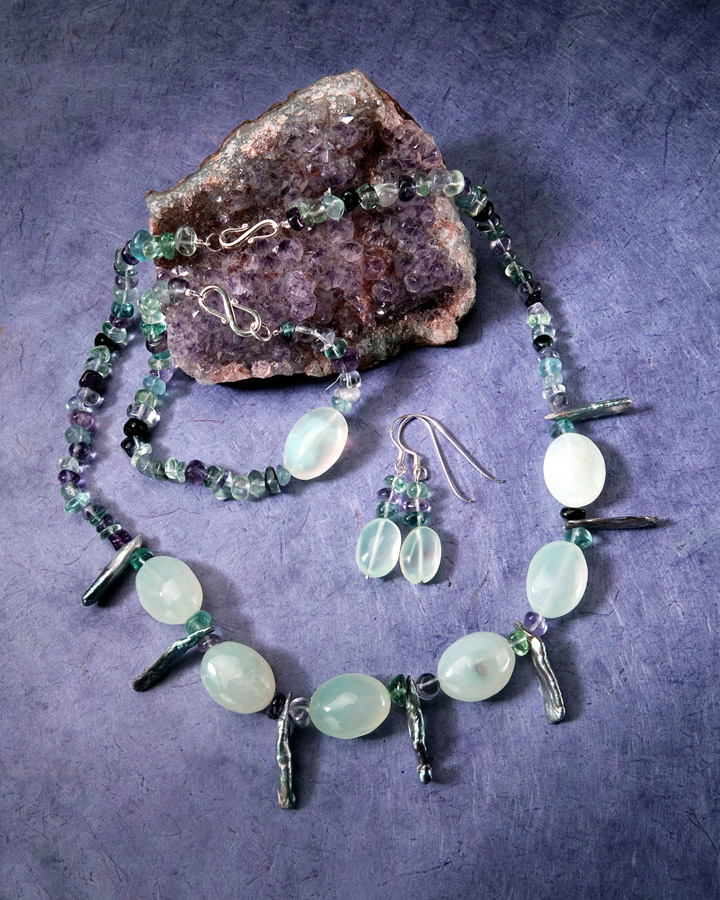I don’t like clasps as a rule. So I sometimes make the necklace 23” so it can be slipped on over the head. If I am limited as to the number of featured gemstone beads I have to work with and can’t make the necklace 23”, I will make use of an uninspired, but helpful (and perhaps necessary) magnetic clasp, to make it easier to put on and off for those who want or need to be independent. I wish I could find beautiful magnetic clasps, but right now women who live with arthritis or other such problems, find that jewelry fitted with these clasps, especially bracelets, are easier to manage.
Also, I have begun to use hook and eyes or S-hooks, as seen above, which are safe but relatively easy to connect. I have even begun making them from Sterling wire and adding a matching bead sometimes! An example is Pewter,Quartz,….
After the press of finishing five sets of jewelry before the final appointment with the photographer, I decided it was at last time to put my work table back in order. As I looked at the remains of three of the sets, I began to see how the iridescent colors of the stick pearls laying there would look good next to some multi-colored transparent Fluorite of the same hues in my collection. I also had some Chalcedony ready to be put away so I decided to try adding a few with the two gemstones I had already seen together in my mind. Yes! Its wonderful translucence gave balance to the opaque and transparent others.
This is a more casual look than the other more elegant “Seafoam” piece. I’m always pleased when I can present a stone in more than one ‘look’, showing its versatility. And by combining a few very costly Chalcedony with less expensive elements, I can moderate the cost of a set that includes the alluring, glowing and rare gemstone (see “Seafoam” Chalcedony and Pearls for more about it).
Please note the unusual location of the featured bead in this bracelet (also see Lodolite, Rose Quartz and Rhodochrosite). Have you ever been frustrated when the accent piece on your bracelet (which is heavier than the rest) kept pulling the clasp (usually the least interesting part of a bracelet) around to the “thumb” side of your wrist? I have, so I placed the large bead nearer the clasp on the back, so the clasp will remain on the back of the wrist where a clasp should stay.
Silvercloud
add title: Seafoam Chalcedony, Fluorite and Pearls
I particularly like to use a bead clasp where the mechanism is hidden in a bead. Clasps can detract from the design, especially if they are ordinary. And if a beautiful costly clasp is added to the piece, it can take over and the rest of the necklace becomes merely something from which to hang that clasp. I much prefer to make a necklace that, when left lying on a woman’s dressing table in a random arrangement (she has more important things to do at the moment), resembles an artful museum display, where a piece of jewelry is “casually BUT oh so carefully” exhibited. Use ‘Cloisonne’ or ‘Carved Chinese Carnelian’
I have begun to use 930 ARGENTIUM (Sterling is only 925 Silver!) in my earrings when possible. It was formulated in the 1990s in England. Researchers found that the addition of a minute amount of Germanium kept the Silver tarnish-free. If after years, it begins to discolor, it is easily restored in the kitchen oven. Imagine not having to polish jewelry!! However, when silver is $35 per oz., just the ARGENTIUM components cost $36 (I may not be able to keep using them). Use R. Quartz & Pearl Briolettes
Lapis sometimes has tiny flecks of Pyrite or Fools’ Gold. It may also include small bits of Calcite, but if they are larger, it is a lower grade and is dyed to obscure them. Personally, I’d rather have a few small inclusions in my natural stones, if I can’t afford top grade. However, I am finding it harder and harder to get natural gemstones of any kind; they are being “enhanced” by heating, radiating and dyeing etc. to make cheaper stones look like the expensive natural gemstones. I will always disclose when stones I use are dyed, if I know it. Unless a distributor makes known any treatment to the stones they offer for sale, I can’t discern it. That’s why I try to purchase my gemstones from the sellers who label their stones. The stabilization of Turquoise is the only treatment I find acceptable. It protects the soft stone from absorbing oil from the wearer’s skin and keeps it from turning greenish, not a bad color, but not my favorite in Turquoise. Use ‘Egyptian Collar’
When the price of gold and silver began to rise, suddenly it was fashionable to wear copper jewelry. I decided to try it out, to see if my prejudice against using any metal other than my usual precious ones was valid. Imagine along with me, if you will: Copper used with pale green beads of Aventurine? All of a sudden I can see how the copper would look next to it; terrific! Like a lovely woman with auburn hair wearing green, right? Oh, I can hardly wait to make a set like that! And what about Peridot beads, or Amethyst or even Citrine? And OH, how about Blue Chalcedony? It seems that only translucent stones work, yes? Lapis Lazuli, Malachite or any other opaque gemstone would not let the Copper be as noticeable or important in the design as it deserves to be (but Olive Jade beads might be quite handsome, don’t you think?). So I say, “If we’re going to use Copper, then let’s allow it to show to itself to its best advantage”. Use ‘R. Quartz, Lodolite & Copper’
